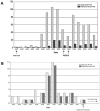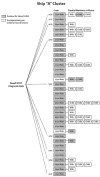Clinical and epidemiologic characteristics of an outbreak of novel H1N1 (swine origin) influenza A virus among United States military beneficiaries
- PMID: 19911946
- PMCID: PMC2878199
- DOI: 10.1086/648508
Clinical and epidemiologic characteristics of an outbreak of novel H1N1 (swine origin) influenza A virus among United States military beneficiaries
Abstract
Background: A novel swine-origin influenza A (H1N1) virus was identified in March 2009 and subsequently caused worldwide outbreaks. The San Diego region was an early focal point of the emerging pandemic. We describe the clinical and epidemiologic characteristics of this novel strain in a military population to assist in future outbreak prevention and control efforts.
Methods: We performed an epidemiologic evaluation of novel H1N1 virus infections diagnosed in San Diego County among 96,258 local US military beneficiaries. The structured military medical system afforded the ability to obtain precise epidemiologic information on the impact on H1N1 virus infection in a population. The novel H1N1 virus was confirmed using real-time reverse transcriptase polymerase chain reaction (rRT-PCR).
Results: From 21 April through 8 May 2009, 761 patients presented with influenza-like illness and underwent rRT-PCR testing. Of these patients, 97 had confirmed novel H1N1 virus infection, with an incidence rate of 101 cases per 100,000 persons. The median age of H1N1 patients with H1N1 virus infection was 21 years (interquartile range, 15-25 years). Fever was a universal symptom in patients with H1N1 virus infection; other symptoms included cough (present in 96% of patients), myalgia or arthralgia (57%), and sore throat (51%). Sixty-eight (70%) of our patients had an identifiable epidemiologic link to another confirmed patient. The largest cluster of cases of H1N1 virus infection occurred on a Navy ship and involved 32 (8%) of 402 crew members; the secondary attack rate was 6%-14%. The rapid influenza testing that was used during this outbreak had a sensitivity of 51% and specificity of 98%, compared with rRT-PCR. Only 1 patient was hospitalized, and there were no deaths.
Conclusions: A novel H1N1 influenza A virus caused a significant outbreak among military beneficiaries in San Diego County, including a significant cluster of cases onboard a Navy ship. The outbreak described here primarily affected adolescents and young adults and resulted in a febrile illness without sequelae.
Conflict of interest statement
Figures




References
-
- Shinde V, Bridges CB, Uyeki TM, et al. Triple-reassortant swine influenza A (H1) in humans in the United States, 2005–2009. N Engl J Med. 2009;360:2616–25. - PubMed
-
- Wells DL, Hopfensperger DJ, Arden NH, et al. Swine influenza virus infections: transmission from ill pigs to humans at a Wisconsin agricultural fair and subsequent probable person-to-person transmission. JAMA. 1991;265:478–81. - PubMed
Publication types
MeSH terms
Grants and funding
LinkOut - more resources
Full Text Sources
Other Literature Sources
Medical
Miscellaneous

